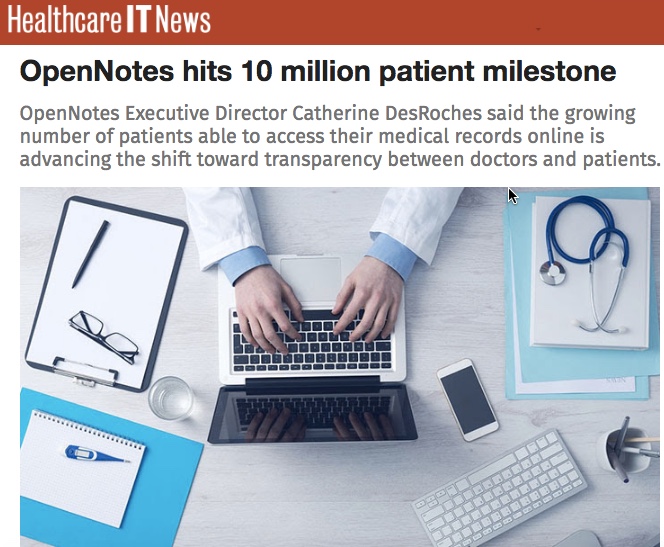 As regular readers know, for years we’ve been blogging here about OpenNotes, in which patients and their designated caregivers can read every word their clinicians write, so they can be more informed. The OpenNotes tagline, “Doctors and patients on the same page,” is no joke: I was one of the subjects in the study, and I’ve blogged about visits with and without OpenNotes. With is better.
As regular readers know, for years we’ve been blogging here about OpenNotes, in which patients and their designated caregivers can read every word their clinicians write, so they can be more informed. The OpenNotes tagline, “Doctors and patients on the same page,” is no joke: I was one of the subjects in the study, and I’ve blogged about visits with and without OpenNotes. With is better.
I mean, would you hold any other kind of important meeting in life with no access to the records of what happened, what was decided, and who’s going to do what??
 This is not just an outer-space crazy idea; in its major 2012 report Best Care at Lower Cost, the Institute of Medicine wrote that “patient-clinician partnerships” with “engaged, empowered patients” are a cornerstone of the future of care. How do we do that? Well, in his keynote speeches and grand rounds lectures, SPM co-chair Dr. Danny Sands says “How can patients participate if they can’t see what I see??”
This is not just an outer-space crazy idea; in its major 2012 report Best Care at Lower Cost, the Institute of Medicine wrote that “patient-clinician partnerships” with “engaged, empowered patients” are a cornerstone of the future of care. How do we do that? Well, in his keynote speeches and grand rounds lectures, SPM co-chair Dr. Danny Sands says “How can patients participate if they can’t see what I see??”
(And in my keynotes, I quote him.:-))
We blogged about the first million patients, and in December we blogged about the new move that will bring OpenNotes to fifty million in the coming years. (That’s 20% of American patients!) Read Bill Siwicki’s Healthcare IT News piece on the 10 million patient milestone … and watch this compelling video of two e-patients who altered the course of their own brain cancer cases(!!!) because they had access to their data … so they could help. (Update: see Liz Salmi’s comment below on how she does not have access to OpenNotes, and she wants it!)
Don’t wait. Ask now.
When crisis hits your family, won’t you want to have this, so you can help, as Vice President Biden described about his own son’s death last year? Do your providers offer it? Ask them now, because although OpenNotes isn’t a for-sale product (it’s just a software switch), these things take time.
Be empowered and engaged – ask now: “Do you have OpenNotes? I’d really like to have it. Whom do I talk to, to file a request?”
And spread the word!






Thanks for sharing this Dave! I love the OpenNotes movement.
Quick correction/nuance:
The video posted above is about how two patients are “open sourcing” their experience. Patient #1 (Steven K.) is doing this through sharing his personal health data, and Patient #2 (Liz) is sharing her patient experience from a qualitative POV.
I am patient #2 in this video, and yes, I referred to myself in the 3rd person in the previous paragraph. I DO NOT have access to OpenNotes from my provider. When this documentary was compiled it was not specifically about OpenNotes so I was not offered an opportunity to comment on my lack of said notes.
Now that I am more informed about OpenNotes I wish I had a chance to clarify that I don’t have the notes. What I do have is access to blood panels and some other basic information. Blah blah blah.
Moving forward, I am excited to do what I can to further the word about the OpenNotes movement.
Liz
Excellent, Liz – I’ll tweak my wording.
I go through a portal to two of my caregivers’ offices (rheumatologist and internist [PCP]). I can copy and save my latest records to share with each other. A little less “automated” than “OpenNotes,” but effective, nevertheless.
Thanks, Elizabeth – the key thing here is that you can SEE the visit notes. (You are talking about the unedited notes, right? Not just a compressed summary list?)
I have several providers that I see regularly. I received a life-threatening diagnosis, underwent brain surgery; and the haze of recovery, I, at some point, clicked on something within my patient portal, and was able to read the detailed notes of my sub-occipital craniotomy. I learned a remarkable amount about my condition and projected recovery- more than my surgeon would ever have had time to convey to me in person-to-person conference.
To this day, I can’t recall how I stumbled into the notes, but I’m so glad that I did.
My other providers provide summary notes via patient portal but those are only blood count readings and whatnot- not the true notes. I will have to ask about OpenNotes.